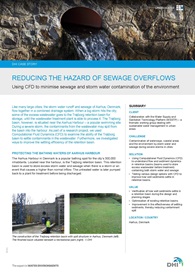We use CFD to minimise sewage and storm water contamination of the environment
We conducted extensive Computational Fluid Dynamics (CFD) modelling in order to reduce the amount of contaminants from spilling into the Aarhus Harbour from Trøjborg retention basin.
 We conducted extensive Computational Fluid Dynamics (CFD) modelling in order to reduce the amount of contaminants from spilling into the Aarhus Harbour from Trøjborg retention basin.
We conducted extensive Computational Fluid Dynamics (CFD) modelling in order to reduce the amount of contaminants from spilling into the Aarhus Harbour from Trøjborg retention basin.
The Aarhus Harbour in Denmark is a popular bathing spot for the city’s 300,000 inhabitants. Located near the harbour, is the Trøjborg retention basin. This retention basin is used to store excess storm water and sewage when there is a storm or an event that causes a higher than normal inflow. The untreated water is later pumped back to a plant for treatment before being discharged.
Like many large cities, the sewage and storm water runoff from Aarhus flow together in a combined drainage system. Although the Trøjborg retention basin has a capacity of 16,000m3, this capacity may be exceeded during severe storms. In such an event, contaminants will overflow into Aarhus Harbour.
Using CFD modelling, we examined ways to reduce the amount of contaminants from the retention basin spilling into the harbour during a storm. By understanding the flow field, we could make improvements in the ability of basins to settle sediments.
Read more